12 Types of Solitaire Games & How to Play Them
By Neal Taparia - Last updated: 10/18/2024
When you want a single-player card game, Solitaire is a great fit, but there’s more than one type of Solitaire you can play. With several versions of Solitaire and a range of difficulty levels, you’re sure to find a game that you enjoy.
In our guide to Solitaire, we explain just what you need to get started playing 12 types of Solitaire. From setting up Solitaire games to the basics of play, you can pair this post with our strategy guide to not only start playing popular Solitaire games but also to keep winning.
Explore different Solitaire games by difficulty:
- Klondike Solitaire Turn 1 (Beginner)
- Klondike Solitaire Turn 3 (Beginner)
- FreeCell Solitaire (Beginner)
- Pyramid Solitaire (Beginner)
- TriPeaks Solitaire (Beginner–Intermediate)
- Spider Solitaire (Beginner–Intermediate)
- Yukon Solitaire (Intermediate)
- Golf Solitaire (Intermediate)
- Canfield Solitaire (Advanced)
- Crescent Solitaire (Advanced)
- Forty Thieves Solitaire (Advanced)
- Scorpion Solitaire (Advanced)
1. Klondike Solitaire Turn 1 (Beginner)
When it comes to Classic Solitaire games, Klondike Solitaire Turn 1 is what you typically think of. Played with one standard deck of cards you try to clear the tableau by moving all cards to foundation piles, arranged by suit and in ascending order from ace to king.
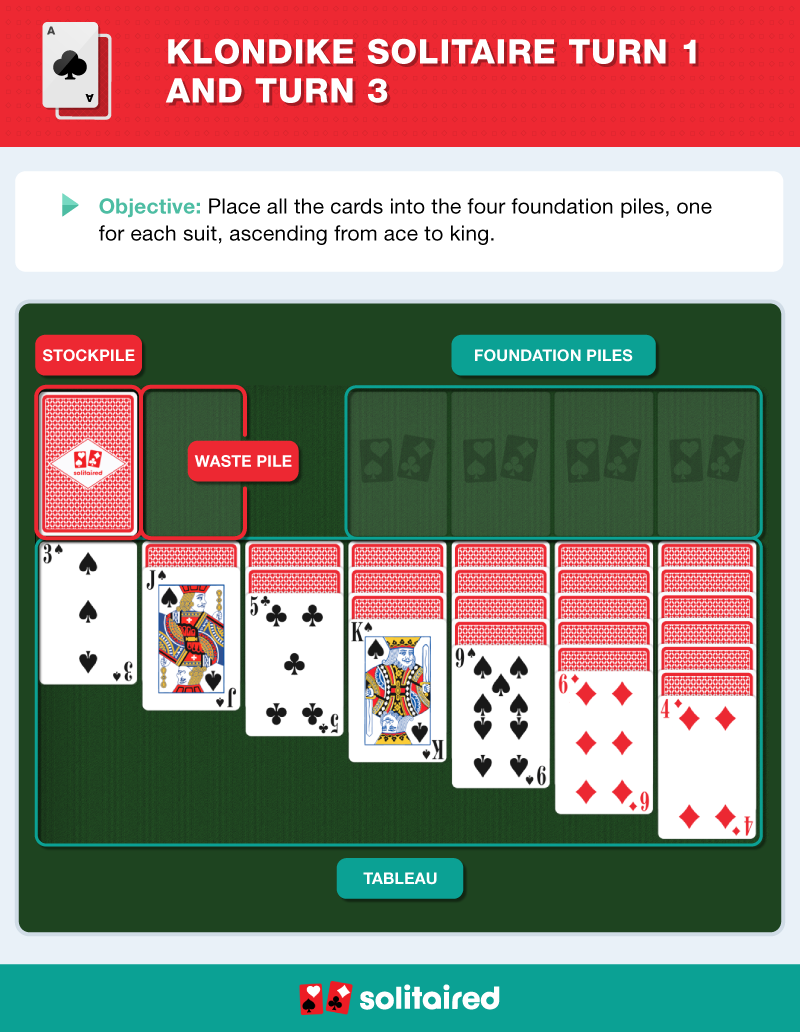
How to set up:
Deal the playing cards onto your tableau from left to right into seven columns. Begin by placing a single face-up card in the first column and one facedown card in the remaining six columns. Keep following this pattern until all seven columns end with just one face-up card. The first column should have one card in total, the second column, two cards, and so on.
The leftover cards become your stockpile, and you reserve four empty spaces at the top of your tableau for the foundation piles.
How to play:
You can only move face-up cards in this game, so you need to arrange cards so that you can reveal and use the facedown cards hidden underneath. Face-up cards can either be placed on foundation piles by suit, starting with an ace and ascending in order, or moved into columns in your tableau by placing them on top of other cards that are one rank higher and a different color. For example, the six of clubs can be placed on top of a seven of diamonds or a seven of hearts.
You can move single cards or entire columns of cards in your tableau as long as the first card (the highest ranking one) is placed on top of a card that is one rank higher and the opposite color. So a sequence of cards that includes a black jack, red ten, and black nine can be moved on top of a queen of hearts or diamonds.
If a column is empty, you can only move a king or a sequence of cards beginning with a king into that space.
Begin the four foundation piles with an ace from each suit, and then place cards in ascending order by suit onto the piles to clear them from the tableau.
When you get stuck and are unable to make moves on the tableau, you can turn over one card from the stockpile into your waste pile. This face-up card can be played on the tableau or onto foundation piles.
2. Klondike Solitaire Turn 3 (Beginner)
If you’re ready for a bit more difficulty, Klondike Solitaire Turn 3 gives you an increased challenge, but is still beginner-friendly. This game is played like Klondike Solitaire Turn 1 except that you have to turn three cards at a time into your waste pile instead of one. The goal is the same though—arrange all the cards into four foundation piles, separated by suit and ascending in order from ace to king.
How to set up:
Just like Klondike Solitaire Turn 1, you use a standard deck of cards and deal your tableau piles the same. Begin dealing seven columns from left to right, with a face-up card in the first column and one facedown card in the remaining six columns. Continue dealing one face-up card followed by facedown cards until all columns end with one face-up card. Each column will have as many cards as its order number, so the first column should have one card, the second column will have two cards, and so on.
Use all the remaining cards for a stockpile, and reserve four empty spaces at the top of your tableau for the foundation piles.
How to play:
The major difference between Klondike Solitaire Turn 3 and the easier version of Turn 1 is that you have to turn over three cards instead of one when using the stockpile. The three cards are turned face-up into your discard pile, and you can use the one on top to play on the tableau or onto foundation piles.
Use an ace from each suit to begin the four foundation piles, which are separated by suit. You add cards to each pile in ascending order and once all cards have been sequenced onto the foundation piles, you win the game.
Arrange cards in the tableau by moving cards into sequences that alternate in color and descent in rank. Because you can only move face-up cards in this game, moving cards into columns helps you target facedown cards in the tableau.
Individual cards as well as columns of cards can be moved on the tableau. But all columns you arrange must descend in rank and alternate in color. So you can move a single black ten onto a jack of hearts or diamonds. Or you can place a sequence of cards that includes a black seven, red six, and black five on top of an eight of hearts or diamonds. Any columns that get emptied must have a king placed in them, and then you use it to build a column of cards.
Face-up cards can also be played onto foundation piles as long as they are separated by suit and ascend in order from ace to king.
3. FreeCell Solitaire (Beginner)
FreeCell Solitaire is a Solitaire variation that still has the goal of clearing the tableau into four foundation piles from ace to king and separated by suit to win. But this variation has a different setup and gives you empty cells for extra spaces to move cards.
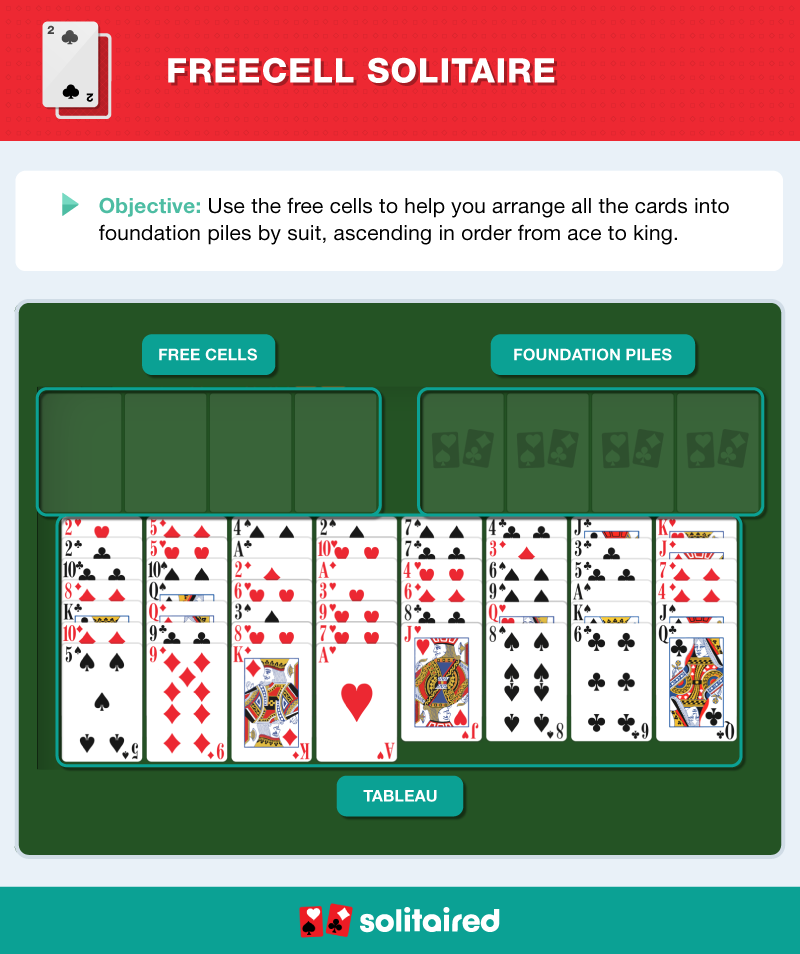
How to set up:
All cards from a standard 52-card deck are dealt face up into eight tableau columns. The first four columns should have seven cards each, and the last four columns should have six cards each. Since all cards are dealt face up, you don’t use a stockpile, but you save four empty spaces above the tableau for foundation piles and four empty spaces—free cells—to help move cards in the tableau.
How to play:
You can only play cards at the bottom of each column in FreeCell, and you can either move them to a foundation pile or place them on another card in the tableau as long as you place it on top of a card that alternates in color and is one rank higher. So you can move a black queen on top of a king of diamonds or hearts.
Like in Classic Solitaire, you can build columns by arranging sequences of cards that alternate in color and descend in rank, and you can use the four empty cells to help you move cards in the tableau. Moving a card to a free cell makes the card under it playable.
The number of cards you have in the empty cells dictates sequenced cards you can move. You can move the equivalent to the number of free cells open plus one. So if you have two cards in the free cells, you can move up to a three-card sequence in the tableau, but not a four-card sequence.
If you empty a column, any playable card can be placed in that column. Unlike Classic Solitaire, it doesn’t have to be a king. Playable cards can also be placed onto foundation piles, but each pile must begin with an ace and ascend to king with each pile dedicated to a separate suit.
4. Pyramid Solitaire (Beginner)
Another winnable Solitaire variation, Pyramid Solitaire sets up and plays differently than Classic Solitaire. While the goal is to clear the tableau of all the cards, you do so by finding pairs of cards that add up to 13.
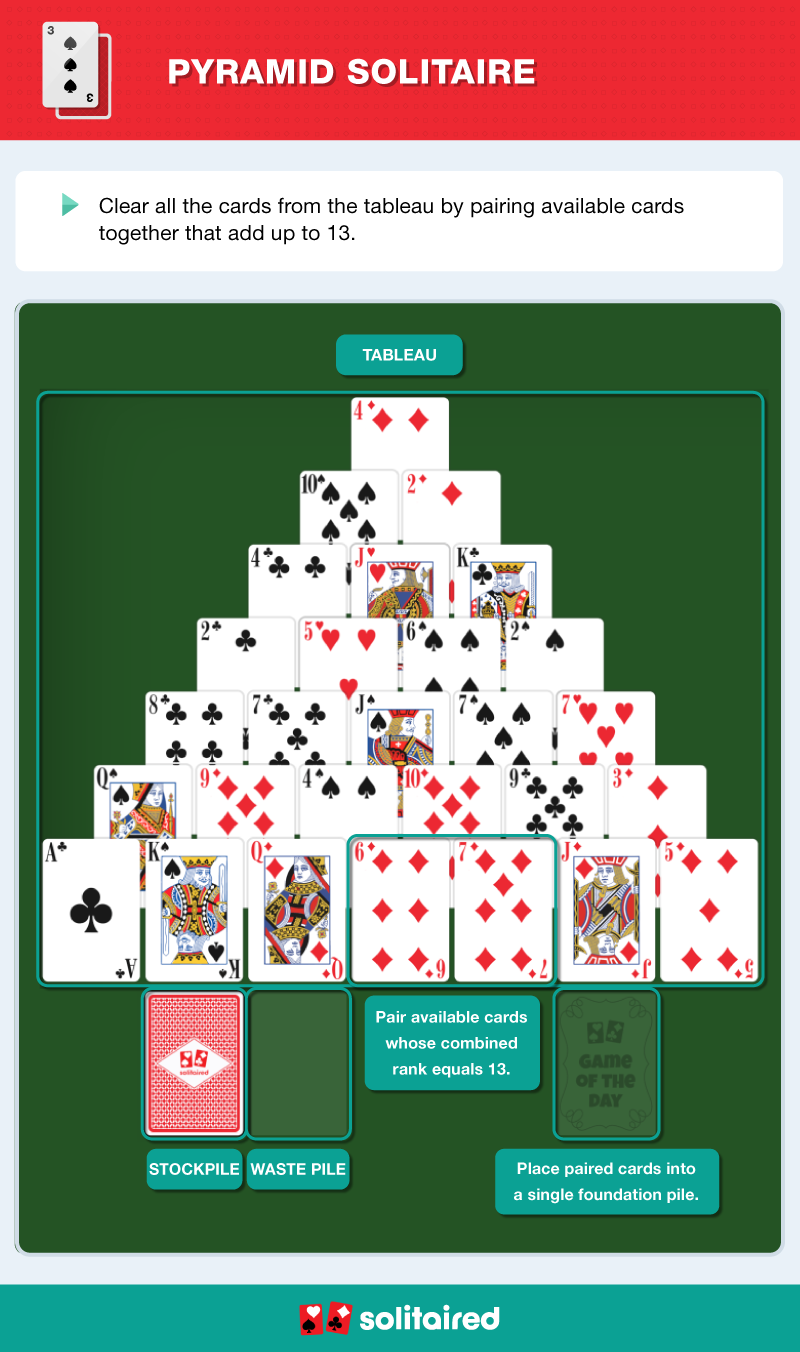
How to set up:
As the name suggests, you set up Pyramid Solitaire in a pyramid of face-up cards. Using a single deck of cards, deal one card, then deal a row below it of two cards, each of which overlaps the single card in the first row. Continue dealing rows that have one card more than the previous row until you have seven rows arranged in a pyramid shape.
The remaining cards become a facedown stockpile, and you use just a single foundation pile to place all paired cards into.
How to play:
Unlike Classic Solitaire, you don’t build columns of sequenced cards. Instead, you pair cards that add up to 13. Kings don’t have to be paired because they equal 13, but queens are 12 and thus need to be paired with an ace, which has a value of one. Jacks have a value of 11 and need to be paired with twos. All other cards equal their rank values.
You can only pair available cards, which are face-up cards that aren’t overlapped by other cards. Any free card in the tableau and any stockpile card turned face up into the waste pile can be used for pairing. Place paired cards into the foundation pile until all cards have been paired.
5. TriPeaks Solitaire (Beginner–Intermediate)
If you’re winning a lot of the beginner-level Solitaire games and require more of a challenge, TriPeaks Solitaire makes a great next step. The tableau of three overlapping pyramids looks similar to Pyramid Solitaire, but instead of pairing cards that add to 13, you simply pair cards that are one rank higher or lower than the waste pile card. You win by removing all the cards from the tableau.
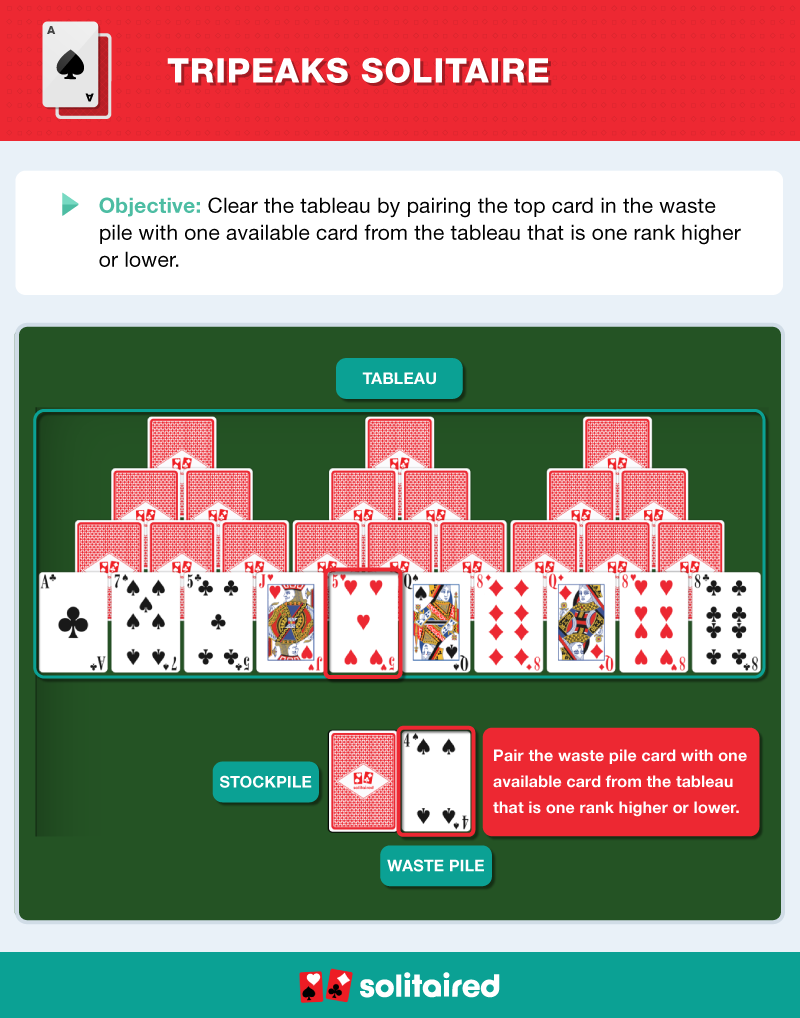
How to set up:
Using a single deck of cards, set up three pyramids of facedown cards in three rows, slightly overlapping. Each pyramid should contain six cards. Deal a final row of ten face-up cards that connect the three pyramids together. There is no foundation pile, and all remaining cards are placed facedown into a stockpile.
How to play:
Flip one card from the stockpile into the waste pile and use it to pair with another card in the tableau that is one rank higher or lower. The card from the tableau becomes the new top waste pile card that you use for pairing.
So if you flip over a five, you can pair it with a six or a four. The six or four then becomes the new top card of the waste pile used for pairing. When you uncover a facedown card, you can flip it face-up. You can only pair with face-up cards in the tableau, and once you pair all of the tableau cards, you win.
6. Spider Solitaire (Beginner–Intermediate)
Another intermediate-level Solitaire variation, Spider Solitaire offers varying levels of difficulty. The easiest level is Spider Solitaire One Suit, then Spider Solitaire Two Suits increases the challenge, and Spider Solitaire Four Suits gives you the highest level of difficulty. In all versions, the goal of the game is to create columns of the same suit in descending order in the tableau, and then completed columns are placed in ascending order into foundation piles.
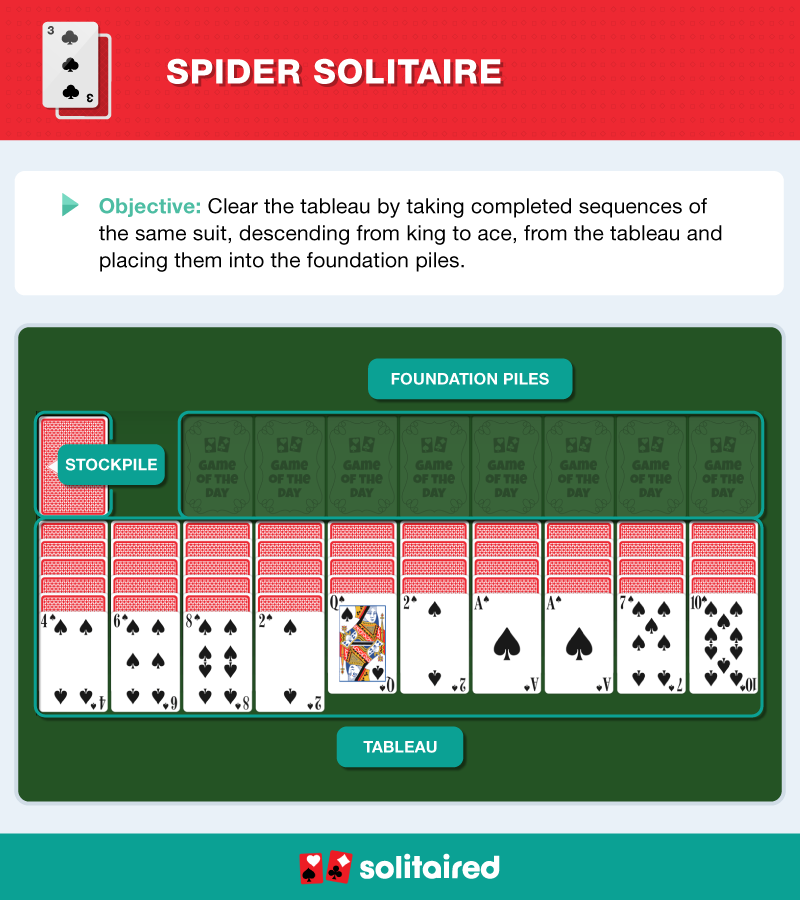
How to set up:
Regardless of how many suits you play with, the setup is the same. Use two decks of cards to create a tableau of 10 columns. The first four columns have six cards each, and the last six columns have five cards each. Only the last card in each column is turned face up. Place the remaining cards into a facedown stockpile and reserve eight spaces for foundation piles at the top.
How to play:
Like most Solitaire games, you can only move face-up cards, and like Klondike Solitaire, you arrange cards into columns. But with Spider Solitaire you arrange cards of the same suit in descending order instead of alternating color.
You can move a single card or you can move an entire column of sequenced cards. You just have to be sure you move them onto a card of the same suit and one rank higher than the highest ranking card in your sequence.
If a facedown card is uncovered, you can flip it over, making it a playable card, and if you empty a column, you can fill it with any rank of card.
When you get stuck and want to use the stockpile, then a face-up card is played at the bottom of every column. Even if the card dealt blocks a sequence, you can begin a new sequence from the new card. You cannot deal from the stockpile if any columns are empty.
Every time you build an entire sequence of cards descending from king to ace, the entire sequence is moved to a foundation pile. You win once all the cards have been sequenced into foundation piles.
7. Yukon Solitaire (Intermediate)
Yukon Solitaire looks similar to Classic Solitaire, but it has some important differences in gameplay. Like the classic version, you have to sequence all cards into foundation piles separated by suit in ascending order from ace to king. However, there is not stockpile to draw from.
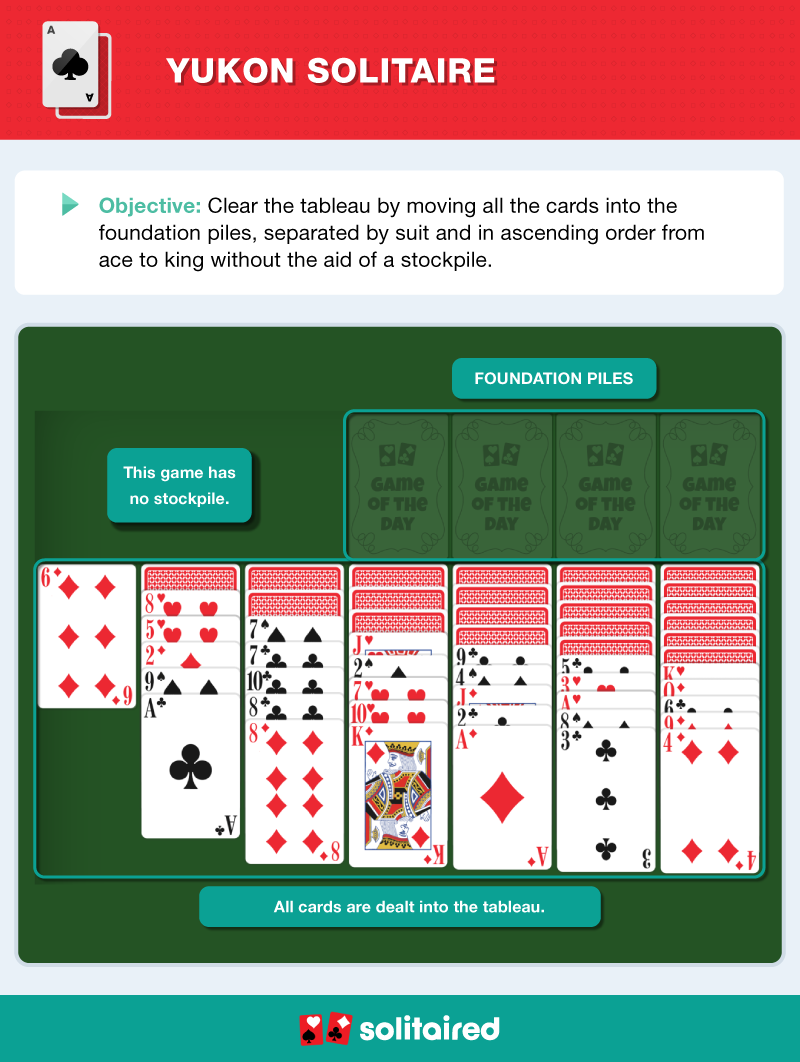
How to set up:
Using a single deck of cards, you deal a tableau of seven columns. The first column has one face-up card, the second column has one facedown card, the third column has three facedown cards, and so on until you deal six cards facedown in the seventh column. All columns but the first end with five face-up cards. Since you deal all the cards, there is no stockpile, and you reserve four spaces at the top for foundation piles.
How to play:
Like Classic Solitaire, you arrange face-up cards in columns descending in rank and alternating in color. You can move single cards at the bottom of each column as well as sequences of cards.
Unlike the classic version, you can move a column of unsequenced cards, too, as long as the card at the top of the column you’re moving is an alternating color and one rank lower than the card you’re placing it on top of.
Available face-up cards at the bottom of each column can also be moved onto foundation piles, which begin with aces and are sequenced in ascending order by suit.
8. Golf Solitaire (Intermediate)
Golf Solitaire is another pairing Solitaire game. Your goal is to clear the tableau by pairing available cards that are one rank higher or lower from the tableau with the top waste pile card.
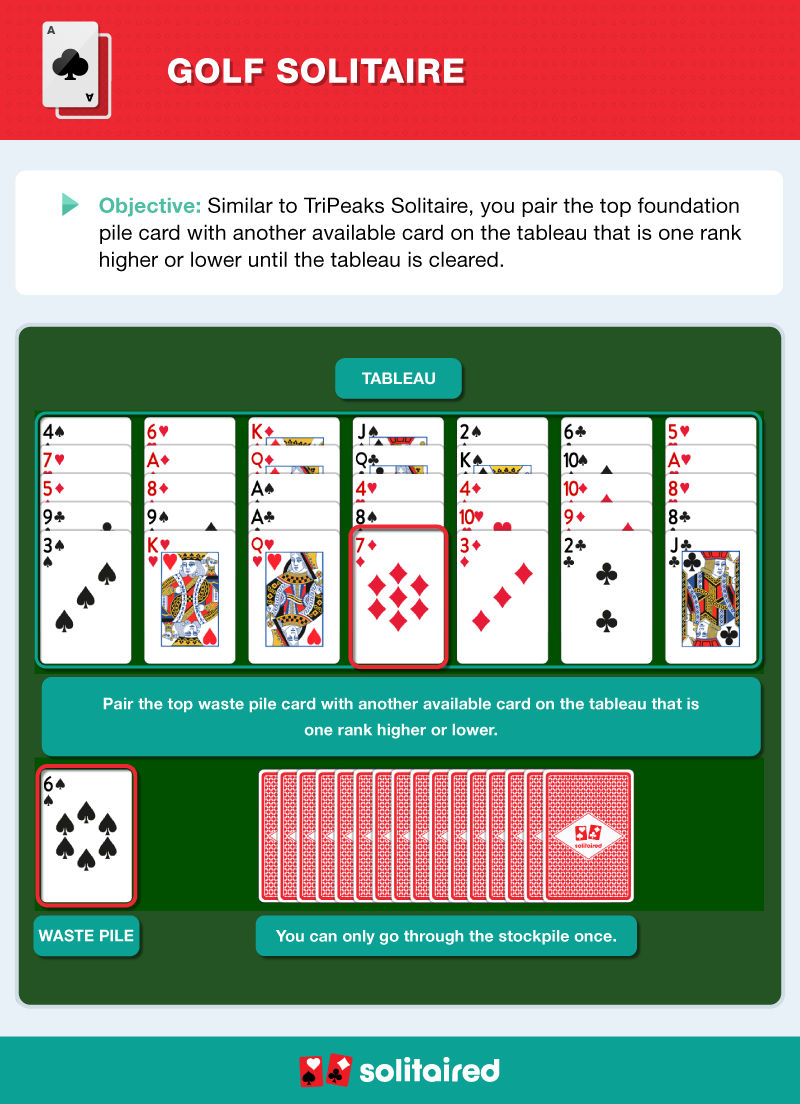
How to set up:
You only need one deck of cards to create the tableau of seven columns, each of which has five face-up cards that slightly overlap the one above it. The remaining cards are put into a stockpile that is spread horizontally below the tableau.
How to play:
Take the first card from the stockpile and flip it face up into the waste pile. This card should be paired with an available card on the tableau that is one rank higher or lower. The paired card from the tableau becomes the next card to be paired.
Available cards are any cards at the bottom of the columns, but if you get stuck, you can flip over another card from the stockpile. However, you only get one run through the stockpile, so once all the cards from the stockpile run out, you won’t have any extra cards to use when you get stuck. You only have to clear the tableau, not the stockpile, to win.
9. Canfield Solitaire (Advanced)
A game that plays a lot like Classic Solitaire, Canfield Solitaire has some unique game rules that make it challenging. Your goal is to place all cards in the foundation piles arranged by suit in ascending wrapping order—a card is flipped into the foundation pile from the beginning, and that card forms the base beginning card for each foundation pile.
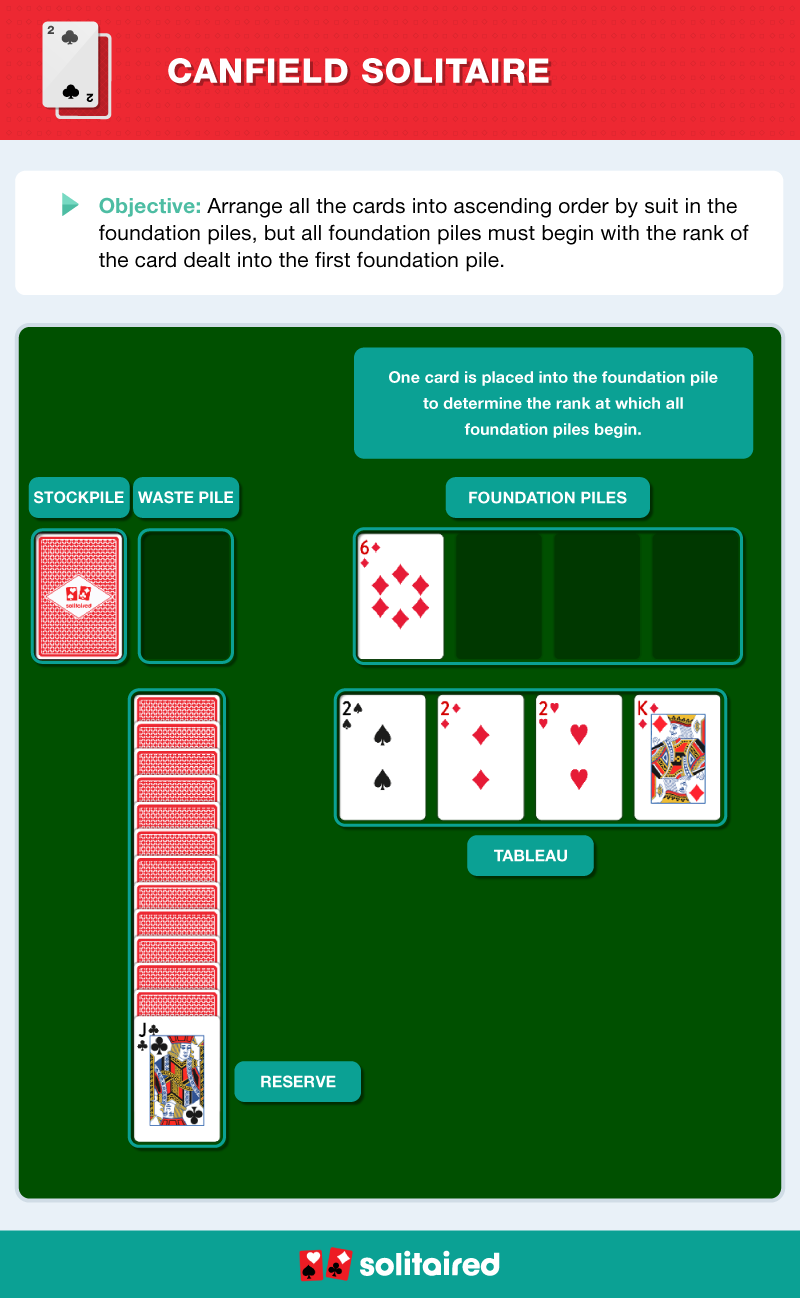
How to set up:
Canfield has a tableau pile that is different from other Solitaire versions. With just one deck of cards, deal the reserve pile by dealing a column of 13 cards down the left side with the last card turned face up. Then you create fewer piles of cards on the tableau—dealing just four columns with only one face-up card each. While four spaces are reserved for foundation piles, one card is dealt into the first foundation pile making it the base card for the rest of the foundation piles. The remaining cards are placed in a stockpile.
How to play:
You play Canfield a lot like Classic Solitaire. You sequence columns of cards in the tableau that descend in rank and alternate in color. Unlike the classic version, you don’t put only kings into empty columns. Instead, you use reserve cards, regardless of rank, to fill empty columns unless the reserve has been depleted. At that point, you can place any card into empty columns.
The biggest difference with Classic Solitaire is the foundation piles. If the first card flipped into the first foundation pile is a nine of diamonds, then all foundation piles must begin with a nine and ascend in rank.
Once a foundation pile reaches the rank of king, you wrap it by placing an ace on top of the king and continuing to ascend until you complete the pile. In the case of beginning foundation piles with nines, the pile would be complete once it wraps back around to eight.
You win by completing the sequences in all the foundation piles.
10. Crescent Solitaire (Advanced)
A challenging variation of Solitaire, Crescent Solitaire uses two decks and requires you to sequence cards into eight foundation piles—four aces foundation piles that ascend in order and four kings foundation piles that descend in order.
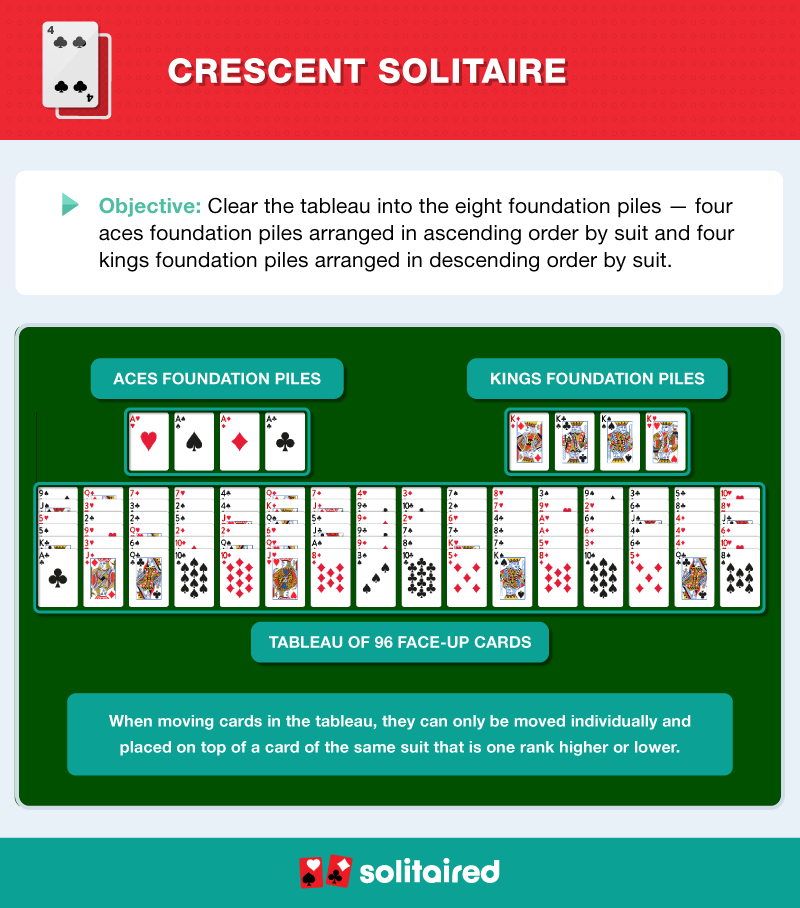
How to set up:
Deal a tableau of 16 columns with six face-up cards in each for a total of 96 cards. Above the tableau are eight foundation piles. Four piles are for aces foundation piles separated by suit, and cards must ascend in rank. Four piles are for kings foundation piles that are separated by suit and that descend in rank.
How to play:
More challenging than Classic Solitaire, you can only move single cards at the bottom of columns onto foundation piles or onto other cards of the same suit in the tableau that are one rank higher or lower. You can’t move columns of cards—only individual cards. You win by sequencing all cards into the eight foundation piles.
11. Forty Thieves Solitaire (Advanced)
Named for the 40 cards dealt into the tableau, Forty Thieves Solitaire is a challenging variation played with two decks. You win by sequencing all the cards by suit into eight foundation piles in ascending order.
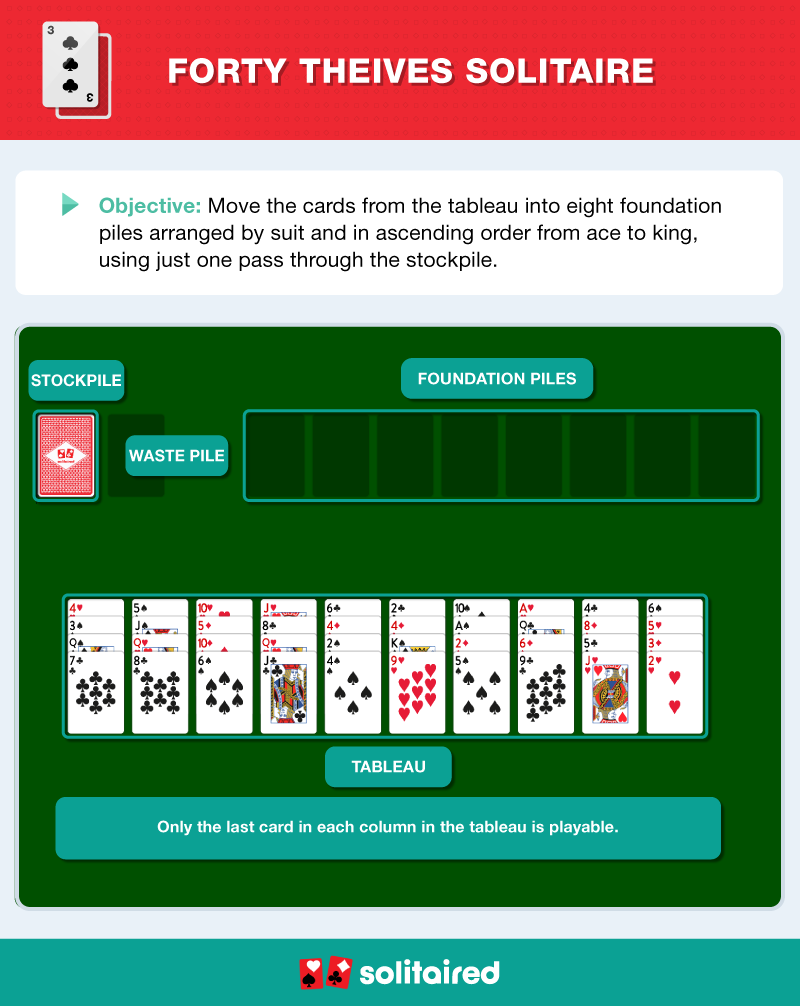
How to set up:
You deal 10 columns with four face-up cards in each to create the tableau. Place the remaining cards in a stockpile and leave eight spaces at the top for the foundation piles.
How to play:
Only cards at the bottom of the columns and the top card of the waste pile are playable. These cards can be placed in the foundation piles or placed in the tableau on top of cards that are the same suit and one rank higher. So you can take the six of spades and move it on top of a seven of spades. But you can’t move columns of cards, only individual ones.
You only get one pass through the stockpile, and if you empty any columns, playable cards of any rank can move into the empty column. All foundation piles must be sequenced in ascending order by suit to win.
12. Scorpion Solitaire (Advanced)
Another advanced variation, Scorpion Solitaire requires you to sequence cards in descending order in the tableau, which are then placed into foundation piles. Sequencing all cards into foundation piles is how you win.
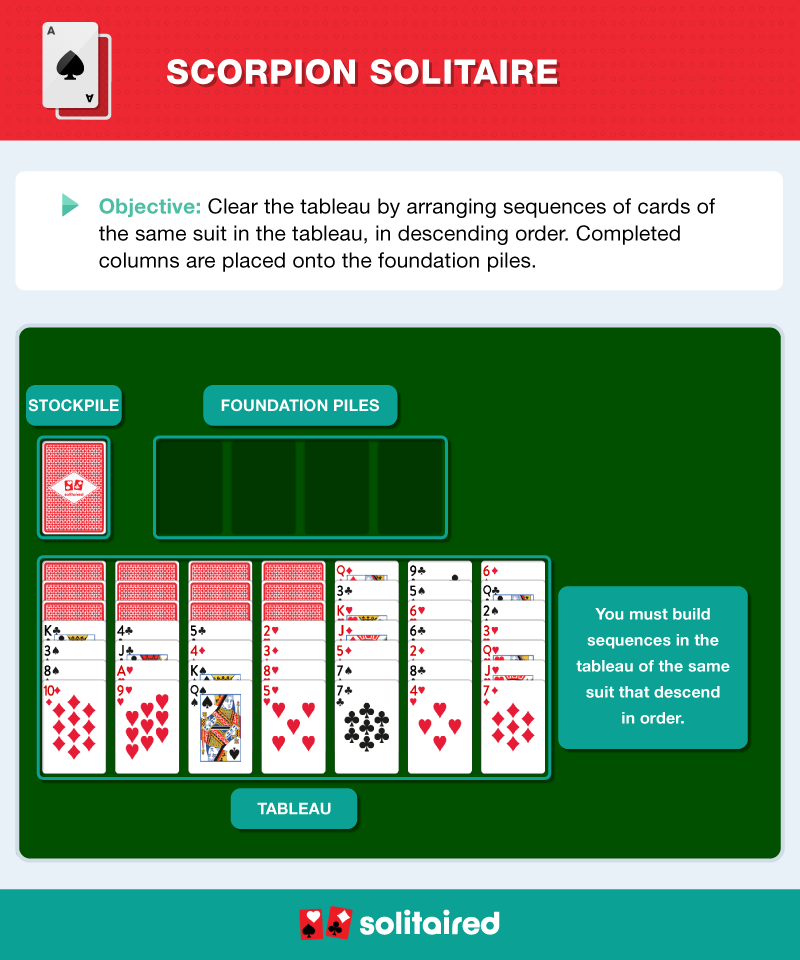
How to set up:
Using one deck of cards, deal a tableau of seven columns with seven cards each. The first four columns have three facedown cards followed by four face-up cards, and the last three columns have all face-up cards. The remaining three cards are placed in the stockpile, and you reserve four spaces at the top for foundation piles.
How to play:
You need to sequence cards of the same suit in descending order in the tableau, and completed sequences are moved to the foundation piles. You can move single cards from the bottom of each column or a face-up card and all the cards after it—even if they’re not sequenced—as long as the card at the top of the column is placed on top of another card one rank higher and the same suit.
Once a facedown card is uncovered, it is turned over to a playable face-up card, and empty columns can only be filled with kings. If you choose the use the stockpile, all three cards are dealt across the bottom of the first three columns.
Play Different Types of Solitaire Games with Solitaired
If you’re ready to play Solitaire and want to challenge yourself in a variety of ways, you can play several different types, from Classic Solitaire to the challenging Scorpion Solitaire, on Solitaired for free without even having to register. Find your new favorite solitaire variation today!
About the author

